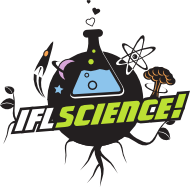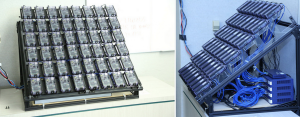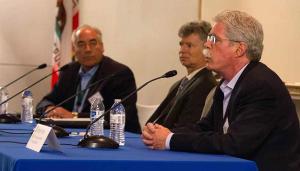LAB REPORT
Science and Technology Making Headlines
Aug. 28, 2015


An array of IBM's "neuromorphic" chips.
Your brain on a chip
Researchers have been working on building a chip since 2008 that works like the neurons inside a human brain. They have developed a system that is made up of 48 million artificial nerve cells, which is about what you'd find in the brain of a small rodent.
“What does a neuro-synaptic architecture give us? It lets us do things like image classification at a very, very low power consumption,” said Brian Van Essen, a computer scientist at Lawrence Livermore National Laboratory. "It lets us tackle new problems in new environments.”
It will take several more years before the chip will be available on the market. Its unique architecture could solve a wide class of problems from vision, audition and multi-sensory fusion, and has the potential to revolutionize the computer industry by integrating brain-like capability into devices where computation is constrained by power and speed.


Skunks turned out to be the culprit of a rabies outbreak in gray foxes when the infection jumped from one species to another.
Getting the jump on viral swarms
Viruses exist as “mutant clouds” of closely related individuals. A new understanding of these swarms is helping researchers predict how viruses will evolve and where disease is likely to spread by jumping from one specimen to another
In 2009, a rabies outbreak in gray foxes in Humboldt County, north of San Francisco, was traced back to a skunk virus that had jumped to foxes. To see when this jump may have occurred, Monica Borucki, a virologist at Lawrence Livermore, used advanced next-generation genetic sequencing to examine the viral swarms of rabies-infected animals going all the way back to 1995. This type of deep sequencing lets researchers search for minor variants in a virus that can acquire mutations and ultimately take over. Borucki found genetic traces of the outbreak virus even in the earliest samples.
The results showed that rare viral variants in an individual provide crucial reservoirs of genetic diversity that can help a virus jump species and evolve. It also offered some of the first clues that could help scientists begin to predict what might happen in the future.


Roger Aines (right), a geochemist who runs the Lab’s Carbon Fuel Cycle Program, discusses a carbon capture technique using microcapsules during a panel discussion at Lawrence Livermore. Photo by Julie Russell/LLNL
Taking charge of energy storage
Lawrence Livermore officials met with energy industry representatives this week to discuss ways in which the two entities can work more closely.
The event highlighted a public-private partnership to engage energy storage companies with LLNL’s world-class research capabilities and facilities through the CalCharge consortium.
During a daylong open house, energy storage industry leaders and innovators as well as Lab officials explained how they will work together to drive research and development of clean energy technologies and specifically energy storage. New green technologies from Lawrence Livermore, Lawrence Berkeley and SLAC National Accelerator also were on display during a poster session.
CalCharge is an energy storage consortium that is accelerating innovation and commercialization of battery technology with emerging and established companies, academic and research institutions, government bodies and financing sources.


Lawrence Livermore National Laboratory engineers Eric Duoss (left) and Tom Wilson use an additive manufacturing process called direct ink writing to develop an engineered “foam” cushion. Photo by George Kitrinos/LLNL
A partnership for meta materials
Lawrence Livermore is working with Autodesk Research to design a next-generation protective helmet.
Under an 18-month Cooperative Research and Development Agreement (CRADA), LLNL will work with researchers at Autodesk’s in-house research wing to put the company’s generative design software to the task of finding new microstructures and arranging them into new configurations.
The research partners say they haven’t decided which kind of sports helmets to create — football, baseball, biking and skiing are all possibilities — but they believe the collaboration could lead to new design methodologies with helmets as just one example.
“The difference in the design method we are proposing versus historically is that many of the previous manufacturing constraints can be eliminated,” said LLNL’s Eric Duoss, a materials engineer and the co-principal investigator with Lab computational engineer Dan White. “Additive manufacturing provides the opportunity for unprecedented breakthroughs in new structures and new material properties for a wide range of applications.”


An artistic conception of the Jupiter-like exoplanet, 51 Eri b, seen in the near-infrared light that shows the hot layers glowing through clouds. Because of its young age, this young cousin of Jupiter is still hot and carries information on the way it was formed 20 million years ago. Image by Danielle Futselaar & Franck Marchis/SETI Institute
New planet is hot, hot, hot
The Gemini Planet Imager has discovered its first exoplanet, a young Jupiter still glowing with the heat of its formation.
Only 100 light-years away, a just-formed gas giant orbits a sun-like star, the infant equivalent of Jupiter in the solar system — and the first exoplanet discovery for the direct-imaging instrument called Gemini Planet Imager (GPI).
51 Eridani b is a gas giant 13 astronomical units from its 20 million-year-old star, which, if it were orbiting our sun, would put it farther out than Jupiter — somewhere between the orbits of Saturn and Uranus. Near-infrared spectra show that this planet’s atmosphere contains methane and water vapor.





